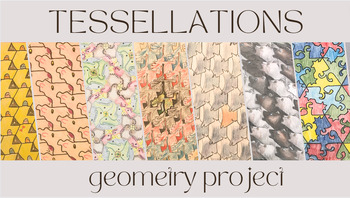Geometry Tessellations Project for Transformations Unit
- PDF
What educators are saying
Description
This tessellations project is a fun way to utilize transformations in Geometry or Art. Students start by creating a fundamental region from either an equilateral triangle, square or hexagon. They cut a unique shape and then translate, rotate or reflect it to another side of the region, thereby creating a piece that can lock together and tessellate across a page. Students interpret their fundamental region and bring the design to life with additional color and drawing.
Younger students can enjoy this project for the pattern making. Older students can make more advanced regions and you may add a component where they describe their procedure for creating their region so that they show their understanding of transformations and the precision required in the placement of their cuts.
As you will see in the included samples of student work, I often had them mount their tessellation to a large sheet of construction paper, add a title, include their fundamental region and a write-up of their process. Another option I've used for displaying student work is to have them post in a shared google slides presentation where each student gets a slide for their work. This works especially well if you have a virtual class, or would just prefer a digital display.
INCLUDED:
- Project description
- Scoring rubric
- Page of equilateral triangles, squares, hexagons for making regions
- Step by step instructions for making fundamental regions and examples
- Samples of student projects
I have done this project during the transformations unit, and also at the end of a school year when we did not have exams. Ending with projects can be a fun way to celebrate!
CHECK OUT THESE OTHER FUN GEOMETRY PROJECTS!
Geometry can be so visual, I love doing one in almost every unit!
BASIC VOCABULARY Logo Design Project
LOGIC Calculator Coding Project
CONSTRUCTIONS Treasure Hunt Project w/Points of Concurrency
TRIANGLE CONGRUENCE Origami "Geometree" Project
SIMILARITY Dilations Cartoon/Logo Project
PYTHAGOREAN THEOREM Pythagorean Spiral
TRANSFORMATIONS Travel Poster/Video Project w/Canva
CIRCLES "Stained Glass" Project





